10 UAS/UUV Threats launched from Ships (Mumm & Ghaffari)
Abbreviations
AI Artificial Intelligence
AUV Autonomous Underwater Vehicle
COTS Commercial Off The Shelf
GPS Global Positioning System
ISR Intelligence, Surveillance, and Reconnaissance
LDUUV Large Displacement UUVs
MCM mine countermeasures
NATO North Atlantic Treaty Organization
SATCOM Satellite communication
SAR Search and Rescue
UAS Unmanned Autonomous Systems
UAV Unmanned Aerial Vehicle
UNCLOS UN Convention on the Law of the Sea
USV Unmanned Surface Vehicles
UUV Unmanned Underwater Vehicles
XLUUV Extra-Large Unmanned Undersea Vehicle
Student Learning Objectives
Students will explore the historical development and integration of Unmanned Aerial Systems (UAS) and Unmanned Underwater Vehicles (UUVs) in addressing maritime piracy and enhancing maritime security. From early military adoption to commercial and civilian applications, UAS and UUV technologies have played transformative roles in surveillance, deterrence, and combat operations at sea. The student will study key historical moments, operational benefits, and challenges while analyzing real-world case studies.
Historical Look at UAS/UUV in Maritime Piracy and Security
Maritime piracy poses a significant threat to global trade and marine operations. The vastness of the ocean creates blind spots in naval monitoring systems, making the early detection of illicit activity difficult. Unmanned Aerial Systems (UAS) and Unmanned Underwater Vehicles (UUVs) have emerged as pivotal technologies in bridging this surveillance gap.
Early Use of UAS in Maritime Security
The early 2000s saw the rise of maritime piracy, especially off the coast of Somalia. Traditional patrol methods were insufficient to cover vast oceanic expanses. UAS such as the ScanEagle, developed by Insitu, were among the first drones deployed by naval forces for maritime surveillance. These drones provided real-time imagery and intelligence, increasing the detection and deterrence of pirate vessels. (“ScanEagle Unmanned Aerial System,” 2025)
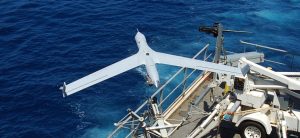
Unmanned Underwater Vehicles (UUVs) and Unmanned Surface Vehicles (USVs) became critical for operations in coastal areas and chokepoints. The REMUS series of UUVs was used for mine detection and seabed surveillance, allowing naval forces to map and secure underwater terrain. These capabilities “can operate independently or teamed with crewed platforms — such as Virginia-class nuclear submarines — expanding operational reach” (“REMUS UUVS,” 2025). This flexibility was pivotal during missions in the Strait of Hormuz and the Gulf of Aden.
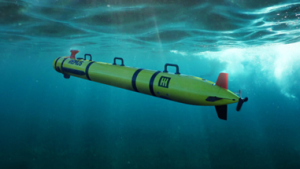
Over the past two decades, UAS/UUV systems have evolved from simple surveillance tools to complex platforms integrated with AI and satellite communication. The rise of swarm technology, where multiple drones operate autonomously in concert, presents both opportunities and new threats. As these systems become more accessible, pirates and terrorist organizations may also adopt them, raising concerns about the potential for asymmetric warfare (Peterson & Hughes, 2022).
UAS Use in Maritime Operations: Limitations and Next Generation Technology
Unmanned Aerial Systems (UAS) have become indispensable tools in maritime operations, enabling enhanced surveillance, reconnaissance, and response capabilities. Despite their benefits, UAS deployments at sea face unique limitations ranging from communication constraints to weather vulnerabilities. This section examines the current limitations of UAS in maritime contexts, reviews real-world deployments, and explores the technological developments that are shaping the next generation of naval drones. Emphasis is placed on autonomous systems, AI-driven analytics, swarm technologies, and multi-domain integration.
The maritime domain presents both opportunities and challenges for the use of UAS. Covering over 70% of the Earth’s surface, oceans are vast, dynamic environments with high strategic value. UAS technologies offer unprecedented reach and persistence for monitoring such areas, aiding in anti-piracy missions, maritime domain awareness (MDA), environmental monitoring, and search and rescue (SAR) operations. However, UAS platforms must overcome operational and technological limitations specific to the maritime theater. Today, navies and coast guards worldwide deploy UAS for tactical surveillance, vessel tracking, anti-smuggling operations, and pollution detection.
Limitations of Current Maritime UAS
While effective in many scenarios, current UAS face substantial maritime-specific limitations. These include:
• Limited endurance and battery life
• Satellite communication (SATCOM) latency or unavailability
• Vulnerability to harsh weather and sea spray
• Challenges in launch/recovery aboard ships
• Electronic countermeasures by adversaries
These constraints limit operational windows and compromise mission reliability.
In an attempt to minimize these limitations, the USS Navy has added the “MQ-4C Triton, the largest unmanned aerial vehicle operated by the USS Navy. Developed by Northrop Grumman, the MQ-4C is a high-altitude, long-endurance surveillance drone built for maritime patrol and reconnaissance.” (“Meet the US Navy’s Largest Unmanned Aerial Vehicle,” 2025).
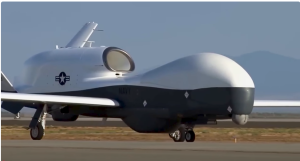
Next Generation Maritime UAS: Autonomous and AI Systems
Next-generation UAS focus on autonomy, artificial intelligence (AI), and multi-drone coordination. These systems will feature improved onboard processing for real-time threat detection and autonomous decision-making. AI algorithms trained on maritime datasets are improving object recognition, vessel classification, and route optimization. Fully autonomous launch/recovery from moving platforms is under development (DARPA, 2023).
In late 2024, the USS George HW Bush, one of theUSS Navy’s nuclear-powered aircraft carriers from the Nimitz-class, recently reached a new level of capability: it became the first in the world to be equipped with a drone control center” (“US Navy Installs World’s First Carrier-Based Drone Control Hub,” 2024). This is a critical component in the Navy’s future vision of being the “control hub for the Navy’s upcoming fleet of MQ-25 Stingray unmanned aerial vehicles and potentially other future autonomous aircraft, transforming how the Navy operates at sea” (“US Navy Installs World’s First Carrier-Based Drone Control Hub,” 2024).
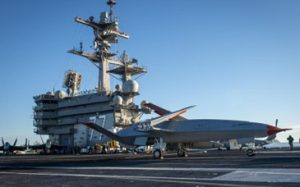
The Navy is working on incorporating the drone control hubs on all “Nimitz- and Ford-class carriers, making them Stingray-capable. Some systems necessary to operate the refueling drone are already being fabricated for the USS Carl Vinson, USS Theodore Roosevelt, and USS Ronald Reagan, with installation scheduled to begin in fiscal 2025.” (Burchett, 2024)
UUV Use in Maritime Operations-It’s a New World
Unmanned Underwater Vehicles (UUVs) have transformed modern maritime operations. These autonomous systems perform critical tasks, including mine detection, intelligence gathering, infrastructure inspection, underwater mapping, and naval operations, as well as UUV applications, operational limitations, technological advancements, and their impact on naval warfare. Additionally, commercial maritime security holds endless future capabilities, such as AI, sensor fusion, and integrated autonomous systems, across various domains.
Underwater domains remain among the least monitored and most strategic environments in global geopolitics. The increasing complexity of maritime threats and vulnerabilities in infrastructure has driven the need for autonomous solutions. UUVs, ranging from portable inspection devices to large, long-endurance submersibles, are now central to military, commercial, and scientific maritime operations.
Civilian UUV Uses
Beyond military use, UUVs support the monitoring of offshore oil and gas infrastructure, undersea cable inspection, and environmental research. As integrated autonomy becomes a greater focus in offshore operations, companies such as EIVA are creating “perception-based navigation and AI-driven guidance…the company’s long-term vision, which includes leveraging AI and real-time 3D modeling for fully autonomous subsea missions.” (Thompson, 2025)
The subsea arena is not simply automating tasks. “The future is about creating truly autonomous systems that can understand their environment, adapt to dynamic conditions, and operate safely without human intervention.”(Thompson, 2025) The maritime industry is in the beginning stages of embracing these new technologies; however, many challenges will slow the progress, including “Regulatory frameworks, data management, and adoption by traditional maritime operators will dictate the speed of implementation. Companies leading this transition must balance technological innovation with operational reliability, cybersecurity concerns, and integration into existing workflows.”(Thompson, 2025) Despite their benefits, UUVs face several limitations. These include:
• Communication latency and limited bandwidth underwater
• Navigation without GPS (relying on inertial or acoustic methods)
• Power constraints limiting mission duration
• Difficulties in launch and recovery in harsh maritime environments
Mitigating these challenges requires continuous innovation in energy storage, acoustic networks, and underwater AI.
Quick Comparison in UUV Size Range From 2-Person Carry to Submarine Class Size
UUVs are categorized by size and their specific functions. As an example of a small light-weight would be the REMUS—: Man-Portable (e.g., REMUS 100) Light weight.
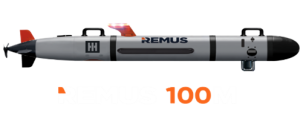
The Orca XLUUV is an example of a heavyweight submersible. Heavy Weight (e.g., Orca XLUUV).
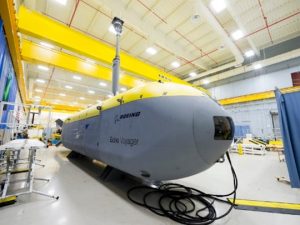
The largest category is based on large water displacement. The Chinese LCUUV image serves as an example in comparison to the American naval prototype in the image below and Large Displacement UUVs (LDUUVs).
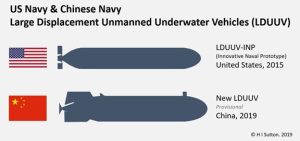
The UUVs perform a wide range of missions, including bathymetric surveys, port security, and anti-submarine warfare. Their modular payloads include sonar systems, cameras, chemical sensors, and acoustic modems.
Modern navies leverage UUVs for intelligence, surveillance, and reconnaissance (ISR), mine countermeasures (MCM), and covert mapping of enemy sea routes—the US. Navy’s Knifefish and Snakehead UUVs are purpose-built for mine detection and ISR. Their stealth, long endurance, and low acoustic signatures make them indispensable in denied or contested waters. (Unmanned Systems Integrated Roadmap 2017-2042, 2018).
The varying sizes and mission capabilities of UUVs are being explored through the Unmanned Systems Integrated Roadmap, represented here, which examines the near-term and future capabilities for this emerging maritime arena.
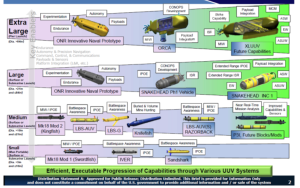
UUVs increasingly operate in tandem with USVs, UASs, and manned vessels. These multi-domain operations enable persistent and layered surveillance. The Royal Navy’s Project HECLA and NATO’s MUSKETEER exercises demonstrate joint robotic operations under contested maritime conditions. (“Integrating Maritime Unmanned Systems into Maritime Operations,” 2023).
Legal and Ethical Considerations
The autonomous deployment of UUVs raises legal and ethical questions regarding engagement rules, data ownership, and cross-border surveillance. The United Nations Convention on the Law of the Sea (UNCLOS) provides limited guidance on autonomous systems. As the use of UUVs expands, new regulatory frameworks are necessary for maritime safety and legal accountability.
Emerging technologies such as underwater quantum communication, advanced battery systems, and synthetic aperture sonar are shaping the future of UUVs. Next-gen platforms will feature enhanced autonomy, secure underwater networks, and deep-sea capabilities, making UUVs even more central to maritime defense and infrastructure protection.
Unmanned underwater vehicles are revolutionizing the maritime domain, providing unparalleled capabilities in ISR, surveying, and security. As technological barriers fall, UUVs will become core assets in both military and civilian fleets. Strategic investment in AI, autonomy, and cross-domain integration is crucial to unlocking the full potential of UUVs in the emerging world of underwater operations.
Underwater Cables, National Security, and the Threat of Autonomous Systems Use
Subsea cables are a vital infrastructure supporting global communication, finance, and security, but they are also susceptible to various risks. The development of maritime autonomous systems increases the ability to monitor and protect these cables, but may also introduce additional vulnerabilities if utilized by hostile actors.
Undersea communication cables form the foundation of the global information infrastructure, reliably transmitting over 95 percent of international digital traffic, which includes internet services, financial transactions, and confidential government communications (Gallagher, 2022). In contrast to satellites, which contribute only minimally to worldwide connectivity, fiber-optic cables facilitate data transfer at speeds and capacities that are indispensable for contemporary operations, ranging from high-frequency trading on Wall Street to the secure transmission of military directives. The critical nature of these cables has rendered them central to considerations of both economic security and national defense.
Although submarine cables are essential to global connectivity, they possess inherent physical vulnerabilities and are susceptible to geographical risks. Typically, no thicker than a garden hose, these cables are laid across the ocean floor for thousands of miles, frequently passing through contested maritime regions and key passageways, such as the English Channel, the South China Sea, and the Mediterranean. The process of repairing damaged cables is both time-intensive and logistically demanding, often requiring several weeks to complete. Unintentional disruptions caused by fishing activities or natural events have led to significant outages in regional communications, highlighting the critical repercussions associated with single points of failure.
The development of maritime autonomous systems increases existing vulnerabilities. Unmanned Underwater Vehicles (UUVs) and other autonomous platforms now possess capabilities such as stealth, persistence, and deep-sea access that were previously associated only with advanced manned submarines. This wider accessibility has made undersea cables more susceptible to activities by various actors. Autonomous systems can be used for espionage, sabotage, or disruption involving the infrastructure that supports global communications and economic activity. In the context of competition among major powers, the protection of submarine cables has become an issue of national and international security (Unmanned Systems Integrated Roadmap 2017–2042, 2018; Sutton, 2019).
Strategic Importance of Underwater Cables
Submarine fiber-optic cables are responsible for transmitting over 95 percent of global communications traffic, encompassing internet services, financial transactions, and secure government communications (Gallagher, 2022). The disruption of even a limited number of critical cables may significantly destabilize financial markets, impede military operations, and result in the digital isolation of entire regions. For instance, previous accidental cable cuts in the Mediterranean have led to widespread connectivity outages throughout the Middle East and South Asia, demonstrating the considerable impact associated with these single points of failure.
Autonomous Systems as Emerging Threat Vectors
Autonomous Underwater Vehicles (AUVs) and Unmanned Underwater Vehicles (UUVs) offer enhanced endurance, stealth functionality, and modular payload capacity, making them well-equipped for cable interaction in both protective and adversarial contexts. The same platforms deployed for legitimate activities such as seabed mapping or infrastructure inspection may also be repurposed for alternative operations, including:
• Espionage – tapping cables to exfiltrate sensitive communications.
• Sabotage – cutting or damaging cables to disrupt command-and-control or global commerce.
• Pre-positioning – placing dormant payloads near cables for later activation in crisis scenarios (Sutton, 2019).
As these vehicles are capable of operating without exposing human personnel to danger, they reduce the barrier for hostile states or non-state actors to undertake such missions.
Known Incidents and Precedents
While much related activity remains classified, open-source sources indicate that countries such as Russia and China have made significant investments in submarine technologies intended to access or monitor undersea cables. For instance, the Russian vessel Yantar has been observed operating near cables in the Atlantic, raising concerns about potential mapping or interference activities. Additionally, China’s development of large displacement unmanned underwater vehicles (LDUUVs) further reflects its emphasis on establishing seabed superiority (Sutton, 2019). These examples underscore the fact that adversarial actors are actively assessing the vulnerabilities of this critical infrastructure.
Gaps in Legal and Policy Frameworks
Current international law, including the United Nations Convention on the Law of the Sea (UNCLOS), contains provisions addressing submarine cable protection, such as prohibiting intentional damage. However, enforcement mechanisms are limited, particularly in international waters (Unmanned Systems Integrated Roadmap 2017–2042, 2018). The convention also does not specify regulations for autonomous systems, resulting in uncertainty regarding state responsibility for unmanned operations. This lack of clarity can complicate the attribution of incidents and the implementation of accountability measures.
Defensive and Resilience Measures
Safeguarding undersea cables against emerging autonomous threats necessitates the implementation of comprehensive, multi-domain strategies:
• Seabed Situational Awareness – deploying UUVs and fixed sensors for continuous monitoring of high-value cable routes.
• Public-Private Partnerships – coordinating with commercial cable operators to share threat intelligence and establish rapid repair protocols.
• Resilient Design – introducing redundancy in cable routes, hardening landing stations, and investing in quantum-resistant encryption to mitigate espionage.
• Military Integration – NATO exercises, such as Dynamic Messenger, emphasize the role of unmanned systems in surveillance and defense; however, more consistent doctrines and capabilities are needed (NATO, 2023).
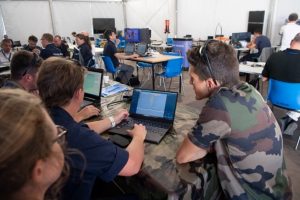
Looking Ahead
As uncrewed underwater vehicle (UUV) technology continues to evolve, the distinction between commercial applications and national security risks is becoming increasingly ambiguous. Advanced platforms, such as the USS Navy’s Orca XLUUV, illustrate the growing normalization of long-range, autonomous seabed operations (Orca XLUUV, 2024). In the absence of equivalent investments in defensive measures and the development of updated international standards, there is a risk that adversaries could capitalize on these capabilities more rapidly than protective forces can respond. Safeguarding the critical submarine communications infrastructure will therefore be a fundamental aspect of maritime security in the 21st century.
Weather Impacts on Maritime Autonomous Systems Use
Maritime autonomous systems, including both aerial and underwater platforms, are particularly susceptible to the impacts of severe and unpredictable weather conditions. In contrast to controlled settings, ocean environments present significant challenges that can adversely affect system performance and mission reliability (Peterson & Hughes, 2022).
Environmental Challenges
• High Seas and Storms – Adverse Sea states can hinder the launch and recovery of UAS from maritime platforms.
• Salt Spray and Humidity – The presence of corrosive agents can compromise sensor performance and diminish the reliability of electronic components.
• Temperature Fluctuations – Rapid thermal variations may impact battery longevity and interfere with proper sensor calibration.
• Currents and Thermoclines – For UUVs, strong underwater currents and stratified thermal layers can decrease navigation precision and disrupt acoustic communications. These environmental challenges elevate mission risk and necessitate increased system autonomy, as real-time operator intervention is often not feasible during extreme conditions (Thomas, 2025).
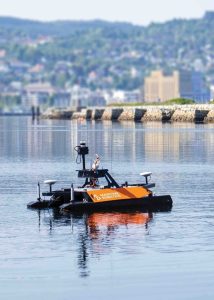
Impacts on Operations
Adverse weather conditions can significantly reduce the operational lifespan of systems and elevate the risk of mission failure. AI-based decision-making processes may misinterpret weather-related anomalies, such as erroneous sensor data resulting from turbulence or fluctuations in water salinity. Furthermore, severe storms and hurricanes have the potential to disrupt satellite communication links, leaving unmanned systems isolated during operations. These disruptions diminish situational awareness and hinder recovery efforts, thereby increasing the likelihood of vehicle loss (REMUS UUVS, 2025).
Mitigation Strategies
Future system designs must be incorporated:
• Adaptive artificial intelligence facilitates seamless real-time integration of weather models.
• The use of resilient materials provides enhanced resistance to both corrosion and mechanical stress.
• Advanced forecasting tools are incorporated directly into mission planning processes, supporting informed decision-making.
• Autonomous recovery protocols ensure that systems can return safely, even in the event of communication loss. These strategies are particularly vital as climate change leads to more frequent and intense maritime weather events, thereby increasing operational challenges for autonomous platforms (Peterson & Hughes, 2022).
Communication Challenges in The Maritime Arena
Effective communication is fundamental to integrated maritime operations; however, the ocean environment presents distinctive and ongoing challenges. These include restricted satellite coverage and limitations in underwater acoustic communications (REMUS UUVS, 2025).
Above-Surface Communication
• Satellite Communication (SATCOM) is a critical component for UAS operations. However, it is subject to latency issues, bandwidth constraints, and potential vulnerabilities such as jamming or denial (Meet the USS Navy’s Largest UAV, 2025).
• Line-of-sight radio is constrained by the horizon range, particularly for moving platforms. Connectivity loss may cause command delays or mission synchronization issues during multi-domain operations (Burchett, 2024).
Underwater Communication
• Acoustic Systems – Unmanned Underwater Vehicles (UUVs) rely on acoustic communication networks, which are inherently limited by bandwidth constraints and latency. These factors hinder the effective transmission of high-resolution video or substantial datasets, thereby impacting mission flexibility and adaptability.
• GPS Denial – Unmanned Underwater Vehicles (UUVs) are unable to utilize GPS signals beneath the water’s surface and therefore depend on inertial navigation systems or acoustic beacons. However, these alternative systems can experience drift over time, which diminishes positional accuracy and presents challenges in coordinating with other operational assets (REMUS UUVS, 2025).
Interoperability and Security
The integration of UAS, UUVs, USVs, and manned vessels presents significant challenges due to differences in communication protocols and encryption standards, which impede effective collaboration and operational efficiency during joint missions. Additionally, these platforms face vulnerabilities from electronic warfare tactics, including interception, jamming, and spoofing. Achieving robust maritime domain awareness necessitates secure and interoperable frameworks to sustain operational reliability among allied forces (NATO, 2023).
Cyber Security Challenges in the New World of Maritime Autonomous Systems
As Unmanned Aerial Systems (UAS) and Unmanned Underwater Vehicles (UUVs) become integrated into both naval and commercial fleets, their reliance on digital networks and autonomous functionality significantly broadens the potential cyberattack surface (Burchett, 2024). The maritime sector presents a complex cybersecurity landscape by combining conventional IT vulnerabilities with distinctive operational technology (OT) risks. These security challenges are not limited to isolated system outages but also have strategic consequences for naval operations, global commerce, and the resilience of critical infrastructure.
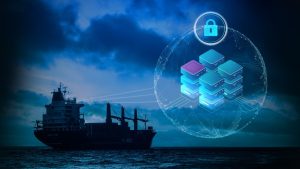
Potential Threats
• GPS Spoofing – Misguiding navigation systems to false coordinates.
• Data-Link Hijacking – Taking control of command-and-control links.
• Malware Injection – Targeting onboard control software.
• Supply Chain Risks – Vulnerabilities embedded in hardware or software components. These threats exploit the fact that many systems rely on commercial-off-the-shelf (COTS) technologies, making them easier targets for sophisticated adversaries (Gallagher, 2022).
• Insider Threats – Contractors and vendors with access to mission-critical systems pose risks if their credentials are compromised.
• Swarm Exploitation – As autonomous swarms become operational, adversaries may target vulnerabilities in swarm coordination algorithms to cause mass failure or redirection.
Implications
Cyberattacks can disrupt or disable unmanned missions, potentially redirecting autonomous platforms against their operators. The weaponization risk is particularly acute for UUVs, which could be repurposed for sabotage missions targeting ports, energy infrastructure, or undersea cables. Additionally, the civil-military overlap of maritime networks means that an attack on naval systems could spill over into commercial shipping and global trade, amplifying economic and security consequences (NATO, 2023).
Attacks against autonomous logistics ships or cargo routing systems could also disrupt supply chains, underscoring the economic vulnerability associated with maritime cybersecurity.
Defensive Measures
Effective defenses will require:
• Layered Cyber Defense tailored for maritime conditions.
• Red-Team Testing to simulate cyberattacks and improve resilience.
• Standards Compliance with NIST and NATO directives.
• Rapid Patching Protocols adapted for deployed systems.
• AI-driven anomaly detection is capable of spotting abnormal behavior in real-time, enabling the quick isolation of compromised assets.
• Zero Trust Architectures help to ensure continuous authentication and segmentation of systems to minimize lateral movement during an intrusion.
• Cyber Resilience Training involves providing naval and commercial operators with the necessary knowledge and procedures to respond to cyber incidents effectively. Implementing these strategies enhances the ability of systems to maintain resilience under challenging cyber conditions (Burchett, 2024).
Conclusions
UAS and UUVs have revolutionized maritime security, enabling persistent surveillance and rapid response to threats. Their historical evolution highlights how technology continues to outpace traditional defense mechanisms. As maritime threats diversify, the continued adaptation and ethical deployment of unmanned systems will be critical for global security. Addressing these challenges requires coordinated innovation in autonomy, resilience, and policy frameworks to ensure that unmanned systems strengthen rather than weaken maritime security.
Questions
1. Are unmanned systems a viable substitute for human operations in maritime security?
2. What are three limitations of UAS in maritime operations?
3. Explain the communication connectivity challenges of UUVs.
References
2024: A year of rising tides in maritime cybersecurity – Midpoint. (2024). https://marpoint.gr/blog/2024-a-year-of-rising-tides-in-maritime-cybersecurity/
Burchett, C. (2024, August 22 2024). Navy outfits aircraft carrier with first drone operations center. Stars and Stripes. Retrieved from https://www.stripes.com/branches/navy/2024-08-22/aircraft-carrier-drone-operations%C2%A0navy-14945493.html
Gallagher, J. C. (2022, September 13). Undersea Telecommunication Cables: Technology Overview and Issues for Congress | congress.gov | Library of Congress. Congressional Legislative Activities. https://www.congress.gov/crs-product/R47237
HII. (2025). REMUS UUVS. Retrieved from https://hii.com/what-we-do/capabilities/unmanned-systems/remus-uuvs/
Integrating Maritime Unmanned Systems into Maritime Operations. (2023). Exercise Dynamic Messenger. Retrieved from https://mc.nato.int/missions/exercises/dynamic-messenger
Meet the USS Navy’s Largest Unmanned Aerial Vehicle. (2025). Retrieved from www.youtube.com/@USM_News
NATO, Integrating Maritime Unmanned Systems into Maritime Operations. (2023). Exercise Dynamic Messenger. Retrieved from https://mc.nato.int/missions/exercises/dynamic-messenger
Naval Technology. (2024). Orca XLUUV, USA. Retrieved from https://www.naval-technology.com/projects/orca-xluuv/O’Rourke, R. (2020). Navy Large Unmanned Surface and Undersea Vehicles: Background and Issues for Congress. Washington, DC: Congressional Research Service. Retrieved from https://crsreports.congress.govR45757
Orca XLUUV, USA. (2024). Retrieved from https://www.naval-technology.com/projects/orca-xluuv/
Peterson, M., & Hughes, L. (2022). Maritime Swarm Tactics: Implications for Naval Warfare. Defense Systems Journal, 39, 41–53. Retrieved from https://www.idga.org/events-counteruas-usa/mediapartners/defense-systems-journal
REMUS UUVS. (2025). Retrieved from https://hii.com/what-we-do/capabilities/unmanned-systems/remus-uuvs/
ScanEagle Unmanned Aerial System. (2025). Retrieved from https://www.insitu.com/products/scaneagle
Sutton, H. (2019). New Intelligence: China’s Navy To Unveil Large Underwater Robot. Forbes. Retrieved from https://www.forbes.com/sites/hisutton/2019/09/29/new-intelligence-chinas-navy-to-unveil-large-underwater-robot/
Thompson, R. (2025). The Next Wave: Transforming Maritime & Subsea Operations. Retrieved from https://insideunmannedsystems.com/the-next-wave-transforming-subsea-operations/
Unmanned Systems Integrated Roadmap 2017-2042. (2018). Washington, DC: Department of Defense. Retrieved from https://apps.dtic.mil/sti/citations/AD1059546USS Navy Installs World’s First Carrier-Based Drone Control Hub. (2024). Online: Defence Central.
